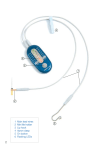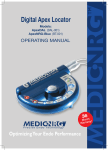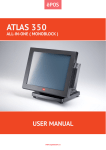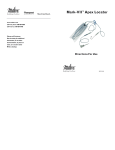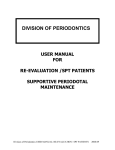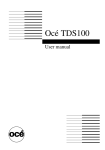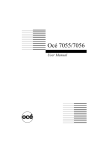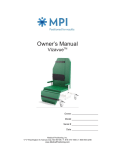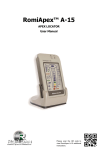Transcript
Apex NRGXFR TM Xtra Fine Resolution 4 6 5 1 1 2 1 2 3 4 5 6 Main lead wires Mini file holder Lip hook Apron clasp On Button Flashing LEDs 3 Digital Apex Locator The Digital Apex Locator is designed to meet international safety and performance standards. Personnel operating the instrument must have a thorough understanding of the proper operation of the instrument. These instructions have been prepared to aid medical and technical personnel to understand and operate the instrument. Do not operate the instrument before reading this manual and gaining a clear understanding of the operation of the instrument. If any part of this manual is not clear, please contact your representative for clarification. The Digital Apex Locator calculates the distance from the tip of your endodontic file to the foramen by measuring the signals between two electrodes. The first electrode is the lip hook The second is the mini file holder which makes contact with a file or plugger that has been inserted into the root canal. Technological advantages for precision • There are 8 LEDs to mark the advancement of the file,for maximal control of the measurement and precision. • The Digital Apex Locator is able to filter out most momentary contact with amalgam or metal fillings. • The Digital Apex Locator provides precise measurements of the canal under all conditions, including wet, dry and bleeding canals. You can immediately measure another canal without any special preparations. • Calibration is automatic, NO manual calibration is required. Initial Setup 1. Insert the two main lead wires into the outlets at the top of the Digital Apex Locator (Pic.B). 2. Insert the file clip and lip hook into the sockets located at the end of the main plug cable (either left or right). (Pic.C+D). pic.B pic.C pic.D pic.E pic.F pic.G 3. Attach the apron clasp to the lead wires by inserting them into the two wire holders on the clasp handles (Pic.E). 4. Insert the Digital Apex Locator into a disposable sleeve. (Pic. F). 5. Place the Digital Apex Locator near the mouth of the patient, and attach the clasp to the apron. (Pic.G). 6. Place the lip hook located at the end of the cable to the lower lip, preferably on the opposite side of the tooth being treated. 7. Place the file at the entrance to the canal (pic.H) and then connect it to the mini file holder located at the end of the file clip cable (pic.I). The Digital Apex Locator is now ready for operation. pic.H pic.I Directions For Use NOTE: The Digital Apex Locator should be used only as an adjunct to normal endodontic procedures. While the unit can reduce the number of radiographs necessary, an initial radiograph must be taken to estimate working length. Clinical judgment, including knowledge of root canal anatomy is paramount when interpreting results. 1. Activate the Digital Apex Locator by pressing the “ON” button on the face of the unit or by making contact between the lip hook and the mini file holder (pic J). Once activated, the LEDs will flash in sequence as a “self-check”. 2. Following this check, the green LED will blink, indicating the Digital Apex Locator is in stand by mode. pic.J 3. When the file reaches the “2.00” mm point, the green LED will stay lit. 4. Work the file towards the apex in a clockwise and counter clockwise circular fashion until the “0.50” mm orange LED turns on and the alarm sounds (slow pitch). NOTE: In order to gain the maximum advantage of this advanced DSP technology, the file must be manipulated in slow movements towards the apical constriction (0.0) in clockwise and counterclockwise motions. This is due to the extremely high accuracy and rapidity of measurement of each minute movement of the file. This is especially important in the critical area between 0.5 to the apical constriction (0.0). Swift movement of the file may cause an unsteady LED display. 5. Before reaching the biological apex, you will reach the “0.25” mm and the orange LED will light. 6. When the file reaches the biological apex, the “Apex” red LED will light and the alarm sound changes to a faster pitch. 7. Mark the depth of the canal with the file rubber stop. Measure the length of the ile and prepare the rest of the files for the treatment according to this length. If you pass the biological apex, the “-0.0” mm red LED will begin to flash and the alarm will sound (fastest pitch). At this stage, gently pull file back out of the canal until the “Apex” mm red LED lights and the alarm sound slows its pitch. Please refer to our recommendations for a successful treatment (page 8) and our trouble shooting guide (page 10) for more information. Device Power Off As an energy-conservation feature, the Digital Apex Locator will turn off after approximately 90 seconds of inactivity. Battery Power When the Digital Apex Locator recognizes low battery power, upon turning on the unit, three intermittent LED lights will simultaneously along with beeping sounds. This is a warning to change the battery soon (still functional). If after an additional period of time the operator has not changed the battery, the unit will turn off automatically upon being turned on and will not allow the operator to use the unit. Replace the battery immediately. There are no other user serviceable items within the unit. Warning! Low battery power affects accuracy. Battery Replacement • Turn over the device so the back side is facing you. • Remove the battery by gently pulling out the battery drawer at the bottom of the Digital Apex Locator (pic.K). • Remove the battery from the drawer (pic.L) and replace with a fresh battery (type CR2450). • Be sure to insert the battery with the + sign facing upwards, to the rear of the device (pic.M) • Slide the drawer back into the battery housing with the + sign to the REAR of the device. Dispose of depleted battery in accordance to local regulations pic.K pic.L pic.M Note: When storing the Digital Apex Locator for a long period without use it is recommended to remove the battery from the device in order to lengthen the battery life Sterilization • Warning! Do not place the Digital Apex Locator into the Autoclave!! • Do not submerge the device or allow liquid to enter the unit enclosure! Attention! The Digital Apex Locator and its accessories are not supplied in a sterile state. All surfaces of the device and its accessories should be disinfected when the unit is initially received and thereafter between procedures, to prevent cross-infection. Wipe the surface of the unit with a clean cloth moistened in 70% ethyl alcohol solution. The main lead wires (1), mini file holder (2), lip hook (3) and apron clasp (4) can be sterilized in the autoclave at 121°C for 20 minutes or at 134°C for 5 minutes. Only accessories specifically mentioned as autoclave safe may be sterilized in the autoclave. For your convenience After the length of the canal has been defined and marked on all of the files, the compact and convenient Sensor Probe can be used to confirm the depth of the entering file during the procedure. The result of the momentary contact with the file will be shown on your apex locator immediately. Please note: Contact should be made increasingly often when approaching the biological apex, in order to prevent perforation. The location of the file will be shown on the apex locator only during direct contact with the sensor probe. Recommendations for a successful treatment Prior to measuring root canal length with your Digital Apex Locator: 3 • Make sure that the pulp chamber 1 is clean and dry before Inserting the measuring file. It is recommended to dry the pulp chamber with a cotton pellet or by a slight aspiration of the moisture (from the root canal as well) with an aspiration syringe. Also ensure that all canals are isolated from each other. Dry the canal with a paper point to increase accuracy when excessive conductive fluids form a conductive bridge between canals or with a metallic restoration or crown. 2 1 • When the walls of the pulp chamber are 4 damaged 2 , saliva leakage can occur from the oral cavity, which will prevent drying of the chamber. A moist chamber will cause the immediate formation of a closed electrical circuit, i.e. a short circuit. In this event the apex locator will issue a warning (red light) as if it reached the apex. In such cases the damaged chamber wall should be permanently or temporarily restored, but only with non-conductive materials such as Composite, IRM, GI (glass iononer) etc. After restoration, an absolutely dry chamber can be achieved and accurate measurement effected. • Check that any damaged fillings 3 have been removed in order to prevent marginal leakage. Such leakage will result in a moist working area and may interfere with the Digital Apex Locator’s reading. The red light will flash, indicating that it has identified the apex when in fact, the file is only at the canal entrance area. • Most momentary contact with metal or amalgam fillings will be filtered out by the Digital Apex Locator. However, continuous contact will ground the device, so take special care to prevent contact between the file and any existing metalbased restoration of the tooth by amalgam filing or crown. In such instances, an adequate insulation of the file from the metallic environment can be achieved by fitting 2-3 rubber stoppers onto the part of the file that may contact the metal of the restoration. • In addition to ensure that the chamber is dry and insulated, take care to remove most soft tissue from the root canal, by extirpation, before measuring. Residual tissue may result in a premature and erroneous reading. • When using a rubber dam, make sure that It provides a proper seal of the insertion area. Any aperture between the rubber dam and tooth can be sealed with a temporary restoration (Cimpat). • Ensure the lip hook fully contacts the patient’s moist mucosa. • Check all connections. • While some of the accessories are autoclave safe, if any accessory seems damaged after a number of autoclave cycles, please replace with a new part. Recommendations for the measurement process Prepare a wide canal oroficium and prepare the first 2/3 in a tapered way to prevent contact with premature constrictions in the canal. • Insert the file while rotating it clockwise and counter-clockwise, and then part way back. Rotation of the file in one direction may cause the file to break inside the canal! • Take care to ensure continuous contact between the file and the root canal wall. It is recommended to use the thickest possible file that will reach the estimated working length. A loose file that does not make continuous contact with the canal wall will be unable to perform accurate measurements. • Ensure continuous and strong contact between the file and its holder (this may be problematic with the thinner files 6, 8, 10 mm). • In excessively desiccated canals, moistening is recommended to improve conductivity. This can be effected by slight irrigation and/or by slight lubrication of the file with CANAL+. • If the canal is too dry, introduce NaOCl to the apical of the canal. Exceptions • In a very wide canal, the Digital Apex Locator may be able to read the measurement only at the tip, where the canal constricts toward the apical tissue. In such cases only a depth of 0,5 mm and apical foramen, will be identified. Reading may be improved by using a thicker file and pressing it against the canal wall. • The apex locator reading may be unstable in these tooth pathology situations: decay (caries), strong bleeding in the canal, metallic restoration, peri-apical lesion, open apex 4 , excessively wide canal. • Bone or periodontal ligament loss (indicated by a radiolucency on the film) can cause inaccurate readings. • A worn out battery will reduce the accuracy of the reading. The battery should be replaced as soon as the instrument's warning signal appears, as detailed in the user manual. Take care to follow the instructions for connecting the cables to the instrument as specified in the user manual. Troubleshooting Question Solution • Unit shows that the file is at the apex when instrument has only just been introduced to the canal. • Either pulp chamber floor is not completely dry or the file has contacted a metallic restoration. In either case, the inaccurate readings are due to shorting the circuit. Dry the pulp chamber if it is wet. • Reading on unit is not steady. • File is in intermittent contact with the canal walls. Either place a curve at the tip of the file or try a larger size file so the tip touches the wall near the apex. • No lights show. • Battery is flat or has not been replaced correctly (see below) • 3 LEDs illuminate simultaneously. • Warning to replace battery as soon as possible. • The reading on the device does not coincide with the result of the X-ray. • The x-ray is a two-dimensional image which cannot accurately find the biological apex. Therefore, the result of the apex locator should be relied upon for determining the correct working length. In addition, bone or periodontal ligament loss (indicated by a radiolucency on the film) can cause inaccurate readings • The unit will not switch off. • Battery is low. Replace battery. • Unit does not work when battery has been replaced. • Please check each of the following points: A. The battery has been placed upside down. B. The battery was not fresh. Please ensure you are replacing with a new battery. C. Please make sure you are using a CR2450 type battery. Included in box • • • • • • • • Digital Apex Locator (1 unit) Lead Wires (4 units) – autoclave safe Apron Clasp (2 units) - autoclave safe Traditional File Clip - autoclave safe Mini File Holder (3 units) - autoclave safe Disposable Sleeves (20 units) Battery (type CR2450) Lip Hook (2 units) Accessories In order to facilitate your operating area, MedicNRG has developed a wide range of accessories that are fully compatible with the Digital Apex Locator • Mini Sensor Probe - autoclave safe (included!) • Long Sensor Probe - autoclave safe Classification • Type BF applied part • IEC 601-1 Compliant Medical Equipment Technical Specifications • • • • • Power Supply: Single CR2450 battery Power input: 2.4 – 3.0 V Maximum current: 12mA Operating temperature: +10°C - +40°C Humidity: 10% - 90% without condensation. Warning! The Digital Apex Locator should NOT be used on a patient with a pacemaker.
